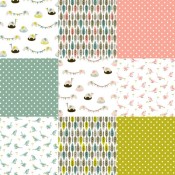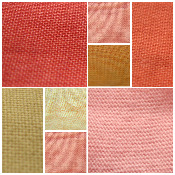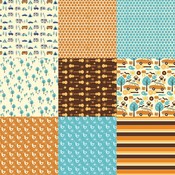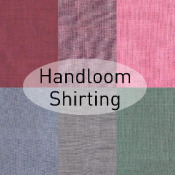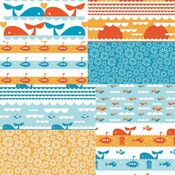Come and visit me at my new blog: A Sewing Journal
About Modern Organic Fabrics
Modern Organic Fabrics is on a quest for organic cotton fabrics that are not-necessarily beige in color. Here, modern is broadly interpreted to mean fabrics that are fresh and modern or just pretty and fun in a large variety of colors. Find ideas for using organic fabrics and a variety of patterns and tutorials, too.
About Melanie O'Brien
Melanie O'Brien is an energetic fabric-aficionado who has turned her focus to organic materials. As she stocks her shop she is searching out bright prints, colors and great design in organic quilting cottons, knits and more. She is also on the lookout for the best patterns and tutorials for utilizing these fabulous fabrics.
Melanie is the mother to three young girls who works from her home in the Milwaukee, Wisconsin area. Before opening Modern Organic Fabrics she was the voice behind The Fabric Shopper blog. She has worked in a variety of industries, including travel and restaurants. She holds a degree in Marketing Communications and a degree in History and Spanish. She has had an interest in living in an Earth-friendly manner since college, when she wrote a paper about garbage dumps (yikes!) She is also a big believer in "doing the best you can".
About organic cotton fabric:
What do you mean by organic cotton?
The Organic Trade Association says it best:
Organic cotton is grown using methods and materials that have a low impact on the environment. Organic production systems replenish and maintain soil fertility, reduce the use of toxic and persistent pesticides and fertilizers, and build biologically diverse agriculture. Third-party certification organizations verify that organic producers use only methods and materials allowed in organic production. Organic cotton is grown without the use of toxic and persistent pesticides and synthetic fertilizers. In addition, federal regulations prohibit the use of genetically engineered seed for organic farming. All cotton sold as organic in the United States must meet strict federal regulations covering how the cotton is grown.
In the US, many of us are familiar with the USDA certification of food crops. The USDA explains organic here: Organic Production and the rules for certification are here: USDA National Organic Program. Since cotton is a global crop, there are many different certifications possible. Every country, or region, may have their own rules for organic crops and some trade organizations or farmers groups do as well. An excellent description of the many different types of organic standards can be found on the website of the IMO (a third party certifier): Organic Certification
Certifying the fabric
Once the manufacturer has the certified organic cotton care must be taken that the production process is environmentally and socially responsible. This is where global groups have stepped in and made sets of standards to be achieved in order to certify the fabric as organic.
One of the most widely recognized group of standards is called the Global Organic Textile Standard (GOTS). You will see that most of the fabrics in my shop have been certified to the standards of this group. Having a global standard ensures that organic cotton production is defined the same way worldwide. The aim of the GOTS is that
Textile processors and manufacturers are enabled to export their organic fabrics and garments with one certification accepted in all major markets.
You can read in much detail about the GOTS criteria here: General Description, but I'm going to highlight some of it below.
Fiber Production:
- Fibers (in this case, cotton) must be certified organic on "basis of recognised international or national standards" (such as USDA NOP)
Processing:
- At all stages, organic fiber must be separated from conventional fiber
- All chemicals must meet basic requirements on toxicity and biodegradability/eliminability
- The following are prohibited: toxic heavy metals, formaldehyde, aromatic solvents, genetically modified organisms (GMO) and their enzymes
- The use of synthetic sizing agents is restricted; knitting and weaving oils must not contain heavy metals
- Bleaches must be based on oxygen (no chlorine bleaching)
- Azo dyes that release carcinogenic amine compounds are prohibited
- All operators must have an environmental policy including procedures to minimize waste and discharges
- Wet processing units must keep full records of the use of chemicals, energy, water consumption and waste water treatment, including the disposal of sludge. The waste water from all wet processing units must be treated in a functional waste water treatment plant.
- Packaging material must not contain PVC
- Minimum social criteria based on the key norms of the International Labour Organisation (ILO) must be met by all processors
Quality Assurance:
- Certification of the entire textile supply chain:
- Fiber producers (farmers) must be certified according to a recognized international or national organic farming standard that is accepted in the country where the final product will be sold
- Operators from post-harvest handling up to garment making and traders up to the import stage have to undergo an onsite annual inspection cycle and must hold a valid GOTS operational certificate applicable for the production / trade of the textiles to be certified
- Residue testing:
- Stringent orientation values for unwanted residues are defined in the standard
- Licensed operators must undergo residue testing according to a risk assessment of contamination
There are other standards that may be used as well. Most notable: Oeko-Tex and Organic Exchange.
Inks and Dyes
Up to this point, we now have certified organic cotton fabric. Often, this means pre-dyeing or printing. Not all certified organic cotton fabric uses dyes and inks certified by GOTS. The reason for this is a bit unclear to me, but the GOTS does supply "approved positive lists containing the trade names of chemical inputs". I've had at least one manufacturer state to me that GOTS-certified dyes were not available in quantities needed to print the entire collection. All of the fabrics in my shop are printed and/or dyed with low-impact dyes and/or inks using no chemicals or substances banned by GOTS.
What are low-impact dyes? You can find an exhaustive and well-detailed explanation about dyes here: O Ecotextiles: Dyes - Synthetic & "Natural" (explains how dyes work, chemicals in dyes and different classes of dyes) First, from the above source, here are the classes of dyes:
- Direct dyes: given this name because they color the fibers “directly” and eliminates the need for a mordant (the chemical fixing agent lots of dyes need). Azo dyes are a type of direct dye made from a nitrogen compound; azo dyes are known to give off a range of carcinogenic particles and have been banned in many places, including the EU. Effluent contains 5 – 20% of original dyestuff, plus salt and dye fixing agents.
- Vat dyes: these dyes need a powerful reducing agent, such as alkali, to make them soluble. Expensive and complicated to use, effluent contains 5 – 20% of residual dyestuffs, plus reducing agents, oxidizing agents, detergents and salts.
- Sulphur dyes: 90% of all sulphur dyes contain sodium sulphide, which endangers life and alters DNA, corrodes sewage systems, damages treatment works and leads to high pH and unpleasant odors. Effluent contains 30 – 40% of the dyestuff plus alkalis and salt.
- Reactive dyes: these dyes bond directly with the fibers, rather than merely remaining as an independent chemical entity within the fiber. Applied with relatively cool water (saving energy)
Low impact reactive dyes are a subset of number 4 above. They have a lower fixation rate and (again, from above source):
What does make them “low impact” and classified by the EU as eco-friendly: they have been formulated to contain no heavy metals or other known toxic substances, and do not need mordants. The high cost of this dye becomes an environmental advantage, as it is cheaper to reclaim dye from the effluent rather than discharge it all and start from scratch. The water can also be recycled. The dye cycle is shorter than it is for other dye processes, meaning less water, salt and chemicals are needed. The entire process normally occurs at a pH of around 7.0, meaning no acids or alkalis need to be added to the water.
As of right now, all fabrics in my shop use synthetic dyes. I will be stocking fabrics with natural, herbal dyes soon. Here, the same source above explains natural dyes in great detail: O Ecotextiles: Dyes - Sythetic & "Natural" part 2
What about Fair Trade?
As stated above, GOTS certification requires that minimum social criteria based on the key norms of the International Labour Organisation (ILO) must be met by all processors. From their website:
The International Labour Organization (ILO) is devoted to advancing opportunities for women and men to obtain decent and productive work in conditions of freedom, equity, security and human dignity. Its main aims are to promote rights at work, encourage decent employment opportunities, enhance social protection and strengthen dialogue in handling work-related issues.
In promoting social justice and internationally recognized human and labour rights, the organization continues to pursue its founding mission that labour peace is essential to prosperity. Today, the ILO helps advance the creation of decent jobs and the kinds of economic and working conditions that give working people and business people a stake in lasting peace, prosperity and progress.
In addition, some fabrics are produced in facilities that are Fair Trade Certified and are noted as such. The key objectives of the fair trade standards are as follows:
- ensure that producers receive prices that cover their average costs of sustainable production;
- provide an additional Fairtrade Premium which can be invested in projects that enhance social, economic and environmental development;
- enable pre-financing for producers who require it;
- facilitate long-term trading partnerships and enable greater producer control over the trading process;
- set clear minimum and progressive criteria to ensure that the conditions of production and trade of all Fairtrade certified products are socially, economically fair and environmentally responsible.
Why is all of this important?
Again, the Organic Trade Association says it best:
Organic agriculture protects the health of people and the planet by reducing the overall exposure to toxic chemicals from synthetic pesticides that can end up in the ground, air, water and food supply, and that are associated with health consequences, from asthma to cancer. Because organic agriculture doesn't use toxic and persistent pesticides, choosing organic products is an easy way to help protect yourself.
They go into much more detail with specifics here: Cotton and the Environment
What about US grown and produced organic cotton?
I'd love to source US-grown organic cotton fabric. At this point, though, there isn't a lot on the market for a variety of reasons. According to Harmony Art (producer of organic cotton fabrics): "... the organic long staple cotton needed for fine fabrics such as sateen are not grown in large enough quantities here in the USA. Most of the USA organic cotton is short staple or Upland cotton."
An overview of types of cotton from St. Geneve: Cotton Types
An excellent blog post about cotton types and telling the good from the bad: Capable Of Flying: I don't care if Monday's blue
About the fabrics in my shop
I provide as much detail as I can about the certifications and dyes used on the fabrics in my shop. If you have any questions about a specific fabric, collection or manufacturer, please do contact me (via link in sidebar) and I can give you more information.

